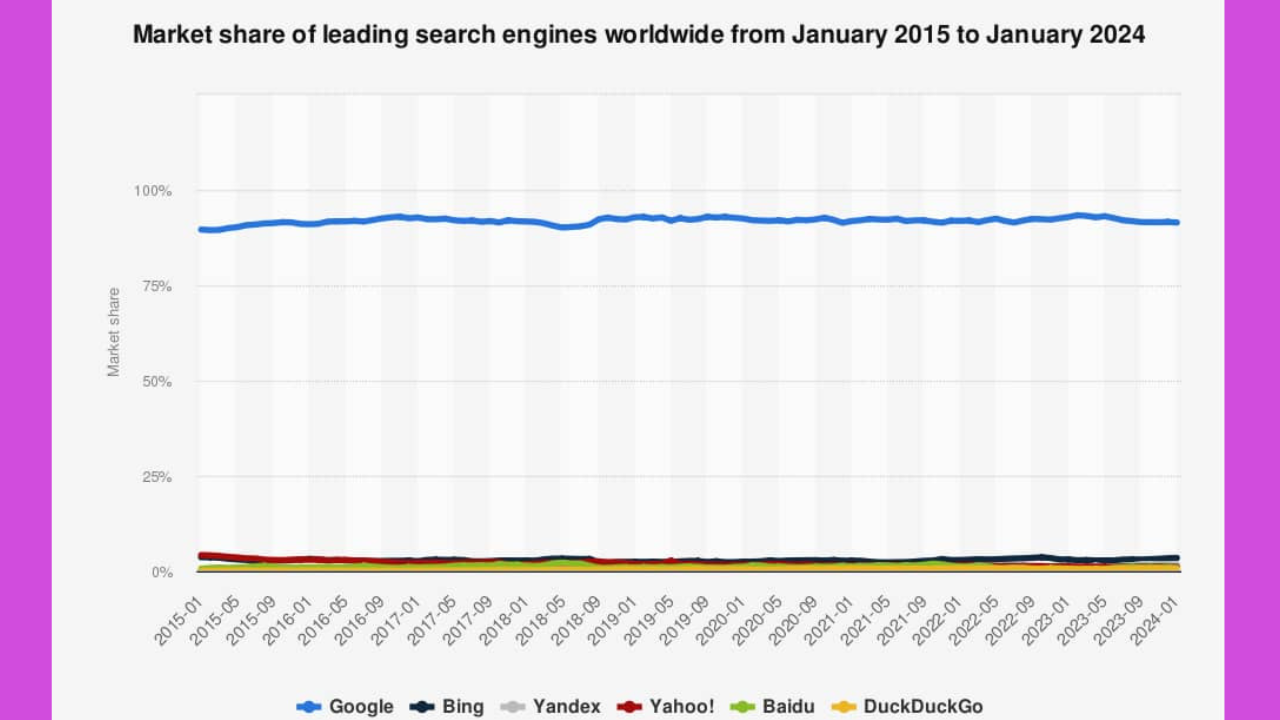Have you ever wondered why some websites rank better than others? It’s because of a marketing technique called SEO.
Today, 94% of consumers and businesses search the internet before buying a new product or service. They input their keywords for search and get a list of relevant websites in return.
People tend to visit websites that are at the top of these lists because they appear to be more relevant to their search.
Studies show that if a website is not at the top of these lists, they will never reach their customers online. This is why many website owners aim to get their website ranked on Google, to reach their customers.
If you’re looking to get started as an SEO specialist to help businesses rank their websites you might want to stick with me as I guide you through.
Let’s get started…
1. What is SEO?
SEO means Search Engine Optimization. This technique helps a site rank higher than the millions of other sites in response to certain keywords when searched.
The search engine system collects information about every page on the web and helps people find exactly what they’re looking for. When a page gets higher rankings, it helps more people to find it.
To achieve higher rankings, a website must have all the ingredients that search engines are looking for. This is where SEO can help.
SEO looks for text content, links, page titles, and other pieces of relevant information contained in the HTML code of a website.
This way, when someone searches for “content writing,” the search engine will narrow the results to show pages that contain the word searched for.
For a business to get more customers, their website has to be on the first page of Google for the specific keywords that are relevant to their potential customers. Without SEO, a site will never be found online by their customers.

1.1 Why SEO is Important?
SEO is an important aspect of online marketing, that is why, businesses that know the value, don’t joke with it. They can go as far as, hiring agencies or freelance SEO specialist to help their websites gain rankings.
Once a site is ranking, and as long as they keep doing things clean and keep following the process, they’re going to stay ranking. Having said this, here are the reasons why SEO is important:
- It helps sites that are following SEO best practices to rank.
- It helps sites provide the right information, product or services to their customers.
- It’s a way to generate passive income.
- It helps businesses gain organic traffic without running ads.
- The traffic SEO generates converts better than paid traffic – If someone searches for “best wireless router,” they’re ready to see wireless router recommendations—that’s exactly what they want at that moment in time.
On a different note, paid ads are clearly incentivized; readers know this person paid money for this ad because they’re trying to make money. While on the other hand, organic traffic generated by a good SEO technique serves people exactly what they want to see when they want to see it and the organic listings at least seem unbiased, because if it’s ranked number one on Google, it must be true.

2. How do search engines work?
Understanding how search engines work is critical to the success of a site because once you know how the system works as an SEO specialist, you can figure out how to beat it.
Let’s take Google for example. The easiest way to think of Google is like a library of books. First, new “books” or webpages come into the library, and then they are organized and put on the right shelf.
Google does that by crawling the web and literally reading every single webpage it finds while following links to find even more webpages to read.
Then all of this gets sorted and added to Google’s index of webpages. Think of indexing as Google’s way of organizing books by topic or author.
When you do a search, Google reviews its index and returns the most relevant results based on your search query.
And that brings us to a very important question: How can you make sure that your client website is the most relevant result that Google returns?
To figure this out, first, you need to understand that Google uses hundreds of ranking factors to decide the order of search results.
But the most important one you need to know about is essentially a voting-based system known as “backlinks,” which means that when one website links to another website, they are essentially “voting” for it. And the more “votes” a website has, the higher it will appear in the search engine rankings.
However not all “votes” are equal. For example, getting a link from Entrepreneur far outweighs a link from an irrelevant website that was launched some weeks back.
Put simply, the more better-quality links or “votes” a website have, the higher they will appear in Google’s rankings.
But not all search engines work in the same way as Google, and every search engine has a different intent. For example, while Google is looking to deliver the best solution, Amazon is looking to return the best product, YouTube wants to return the most relevant video, and Quora wants to display the most accurate answer.
And each of these search engines has different ranking factors that go into them. For example, Amazon uses a combination of conversion rate, relevancy, buyer signals, and ratings to order their search results, which is totally different from how Google works.
So before you start optimizing for any search engine, you have to ask yourself: “What does the search engine want?”
Because once you understand what it wants, you can start figuring out how it works to make sure that your website, product, or video always shows up on top.
Second method that helps you understand how Google works, are keywords and keyword placement, and domain authority.
Your metadata must include your title tag, description tag, H1 tag, and the text for your images. And you must ensure that your keywords are in these areas.
Another ranking factor is page load speed. If a website doesn’t load within three seconds, more than 50% of people will leave. A fast-loading website is crucial for good user experience and SEO. There is a free tool called pagespeedinsights to check your website’s speed.
Domain age is another ranking factor that is consider by search engines. The older your domain, the better. If you bought a domain 20 years ago, that’s great, but if you bought it yesterday, you’ll have to work with that. Keywords in your domain name can also help. For example, an Italian restaurant in Brooklyn might benefit from a domain name containing words like “restaurant,” “Brooklyn,” or “pizza and pasta.” However it’s not a compulsory factor, that all businesses must have their keywords in their domain for good ranking.
3. How SEO differs from SEM and PPC
A lot of people confuse SEO and SEM, largely because they are related. And they see SEO as marathon, however SEO, search engine optimization, is what you can do to your website from an onsite perspective to make it favorable in the search engine.
SEM, Search Engine Marketing comprises of link building and guest posting strategies to establish your site’s authority through partnerships with authoritative websites.
In contrast, PPC (Pay-Per-Click) involves participating in a bidding process for ad placement on platforms like Google Display Network and AdWords. This results in sponsored content appearing in search results, labeled as ‘Ad’. To summarize:
- SEO (Search Engine Optimization) is within your control, focusing on optimizing your website.
- SEM involves collaborations with other websites to build authority.
- PPC requires investing in advertising to increase visibility on search engines.
You can key into any of these strategies to drive traffic to your site, based on your budget and preferences.

4. SEO types and specializations
SEO is what improves a site’s visibility, authority, credibility and conversion rate. However, there exist different types of SEO and if you’re looking to improve your website’s ranking you need to know about them.
Three Core Types of SEO
The three core types of SEO are the foundation that everything else is built on whenever we’re thinking about SEO.
1. On-Page SEO
On-page SEO involves elements that you can see when you pull up a page and analyze it from an SEO perspective. Often, these are things that a plain visitor can see as well, such as title tags, Meta descriptions, content on the page, and keywords that are present or not present.
Essentially, it’s anything within the HTML that’s being read by a browser and search engine bots. It’s about making sure there’s the right amount of content on the site, explaining things in ways that make sense to users, and having everything mapped out perfectly with a well-planned on-page SEO strategy.
2. Off-Page SEO
Off-page SEO includes everything that’s happening outside of the pages on your website. Search engines look at what’s happening on other sites that are talking about your website, linking to it, or mentioning it. These are significant signals of trust and relevance.
For example, if one company has a million links and mentions, Google is likely to boost them compared to a site that only has 15 mentions. A key part of off-page SEO is a digital PR strategy—creating content that will naturally earn links and discussions around the web, tying into your overall SEO strategy.
3. Technical SEO
Technical SEO is where we bring in our developer friends and analyze the site from a code level, dig into the server setup, and analyze things like page speed—how fast the site loads for users and whether search engines can access it.
This involves checking server-level elements to ensure the site is indexable and crawlable by search engines. For large sites, especially in technical e-commerce spaces, technical SEO can simplify things, improve performance, and ensure all the on-page and off-page SEO efforts are effectively integrated.
5. How to learn SEO
I came to know about SEO 4 years ago, when I first launched my website that failed. I remember struggling a lot to grasp the technicalities that surrounded it. Today all of those struggles have gone and I’ll show you how to learn SEO and become an expert.
Step one: Master the Fundamentals of SEO and know why it all fit in together. You don’t want to skip this phase. You need to know why backlinks are important to acquire. Why your title tags should have your focus keywords, how to use Longtail keywords in the right other, etc.
Step two: Put SEO into practice. You can watch videos about SEO all day long, but if you want to be good at SEO, you need to do SEO. There are 2 ways to go about this, it’s either you own your own website and learn or you can create a free account with us at Inkwrit and start writing not only that you get to receive feedback from us on how you are doing SEO-wise. The latter will help you save time, and money and speed up your learning.
Step three: Experiment and learn. This is similar to step two, but if there’s one thing that separates SEO experts from SEO newbies, it’s this: SEO experts are always testing. That said, SEO can be a tricky thing to test, so if you want to run SEO experiments, here are a few things to keep in mind as you go through the process:
Focus on testing the right things. In theory, you can test literally anything, but in practice, I recommend focusing on these things: link building strategies, content formats, and paid social media promotion.
Step four: Scale your SEO tasks. When you try to scale up things, it stretches you beyond your imagination and helps you achieve more feat.
6. SEO tools

Seedkeywords.com: The first tool I’m recommending is called Seedkeywords.com. Instead of going the traditional route of just inputting a keyword into any keyword research tools, you can use Seed keyword to create a scenario. Rather than pulling seed keywords out of thin air, you actually ask customers what they think about XYZ. Then you use those seed keywords in a general l keyword research tool and you’ll find some untapped keywords that your competitors don’t know about yet.
SERPerator: This is a free SEO tool, and it helps you check out the search results across different locations and devices. All you need to do is specify your device and location, and you’ll see exactly how the results will look for someone searching from that location, using that device.
Exploding Topics: You probably already know that finding new trending keywords is an SEO goldmine, and it’s simple math. If you target an old keyword, there will be more blog posts, articles, YouTube videos, and content in general that you have to compete with. But when you target new keywords that are trending up, you get in early before the search results get super competitive.
The question is, how do you find these new trending terms? Well, you could use Google Trends, but the issue with Google Trends is that you already need to know what you’re looking for. In other words, Google Trends is great for confirming a trend on a keyword that you already know about, but it’s not really helpful for coming up with new trends and topics. With Exploding Topics, you get a list of new trending keywords presented to you on a silver platter if you go for premium.
LSI Graph: You’ve probably heard of LSI keywords before. They’re basically words and phrases that are closely related to your main keyword, and when you include these terms in your content, Google sees your content as comprehensive, which can give you a nice little rankings boost.
For example, let’s say your target keyword is “Star Wars.” LSI keywords for “Star Wars” would be things like Luke Skywalker, Jedi, Princess Leia, and the Millennium Falcon.
So, how do you find LSI keywords? This is where LSI Graph comes in. Just enter your target keyword into the tool, and you’ll get a list of LSI keywords that you can sprinkle into your content. It’s not free, however you can use Chatgpt to generate LSI keywords for free and another way to generate LSI keyword is shown in the video below.
Wordtracker Scout: Wordtracker Scout takes a unique approach to keyword research. Instead of entering a keyword into a tool, Wordtracker scans a page and finds keywords that show up over and over again. That way, you can go over to one of your competitor’s pages and grab the keywords that they’re already using in their content. You can even sort the list of keywords by opportunity, which are terms that have the best ratio of search volume and competition.
Google Search Console: No list of SEO tools would be complete without talking about Search Console. Why? Well, if you take a step back, Search Console is actually a pretty feature-rich piece of SEO software. And unlike almost every other tool in the market, the data that you get comes straight from Google, so you know it’s legit. For example, you can use the Search Console as a rank tracker to check your site’s ranking in the SERPs. You can also use it to get a feel for your site’s backlink profile. Now, this isn’t nearly as good as a paid tool like Ahrefs, but it’s not terrible. Last but not least, you can see all of the pages that your site has indexed in Google, and if you have any technical SEO problems that’s holding your site back.
Answer The Public: This powerful tool was created by Neil Petal, a digital marketing guru. Answer The Public is a tool that focuses on questions that people ask on forums, Quora, Reddit, blogs, and on social media, and it turns those questions into awesome keywords. The best part is that it has a section dedicated to versus keywords.
Why is this helpful? Versus keywords are great for SEO. That’s because versus keywords usually aren’t super competitive, and the people that search for versus keywords tend to be pretty advanced, which means they’re usually close to buying something. When you come up with an article for this kind of keywords you’re sure to rank within few weeks.
Animalz Revive: Animalz Revive is an SEO tools that helps you find older content on your site that needs an update and upgrade, or both. Before this tool came along, you had to manually find these pages in Google Analytics, and it was a huge pain. But with this tool, you get a list of pages that need some TLC. It even shows you how many visitors you’re losing by not updating your old content.
Siteliner: Siteliner is a free technical SEO tool that scans a site for SEO problems like blocked pages, messed up redirects, duplicate content, and broken links. You can even drill down into each page on your site to see if the tool found any issues. You can also compare your site’s loading speed and page size to other sites in Siteliner’s database, which is helpful for benchmarking.
7. SEO Strategies: White Hat vs. Black Hat
White Hat vs. Black Hat SEO; what’s the Difference? If you’re new to the world of SEO, you might be wondering what the difference is between white hat and black hat SEO practices.
In a nutshell, white hat SEO refers to techniques used to improve search engine rankings in a way that aligns with the terms and conditions set by search engines. Black hat SEO, on the other hand, uses techniques intended to game the system and improve rankings in an unethical or unnatural way.
If you’re just getting started with SEO, it’s important to focus on white hat techniques. Not only will this help you avoid any penalties from search engines, but it will also set you up for long-term success.
Common Black Hat SEO Techniques to Avoid
1. Keyword Stuffing: This refers to the practice of cramming as many keywords into your content as possible in an attempt to artificially improve your rankings. Not only does this irritate readers, but it can also get you penalized by search engines.
2. Hidden Text or Links: This is a technique used to hide text or links on a page in an attempt to manipulate the search engine rankings. This is considered a black hat technique because it’s intended to deceive search engines and users.
3. Cloaking: This is a technique that shows one version of a page to users and another version to search engines. The version shown to search engines is often stuffed with keywords and designed to artificially improve rankings.
These are just a few examples of black hat SEO techniques. If you’re unsure whether a technique is considered black hat or not, it’s always best to err on the side of caution and avoid it.
Let’s wrap up
68% of online activity starts with a query in a search engine like Google or Bing. Identifying the right word to include in your content is essential. According to Ubersuggest, 89% of keywords get only 10 monthly searches or fewer. And according to Ahrefs, only 0.16% of the most popular keywords are responsible for 60% of all searches.
What this tells us is that if you want your keywords to actually show up in your audience searches, you have to choose them extremely carefully. SEO is not a strategy where you can guess and hope for the best, rather SEO is a systematic approach and you have to be ready to apply the process that will lead to inflow of traffic either to your website or your client’s. Either ways, never try to outsmart the system but rather take time to discover what works and what doesn’t.




